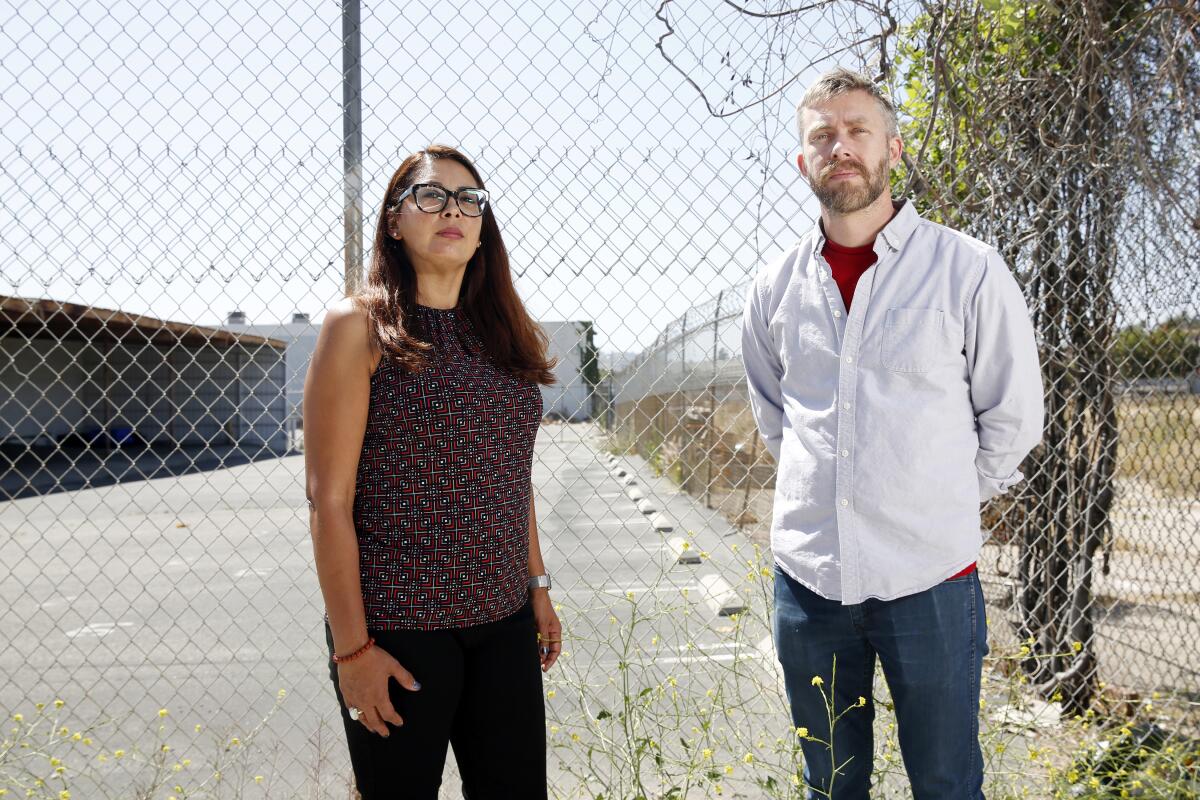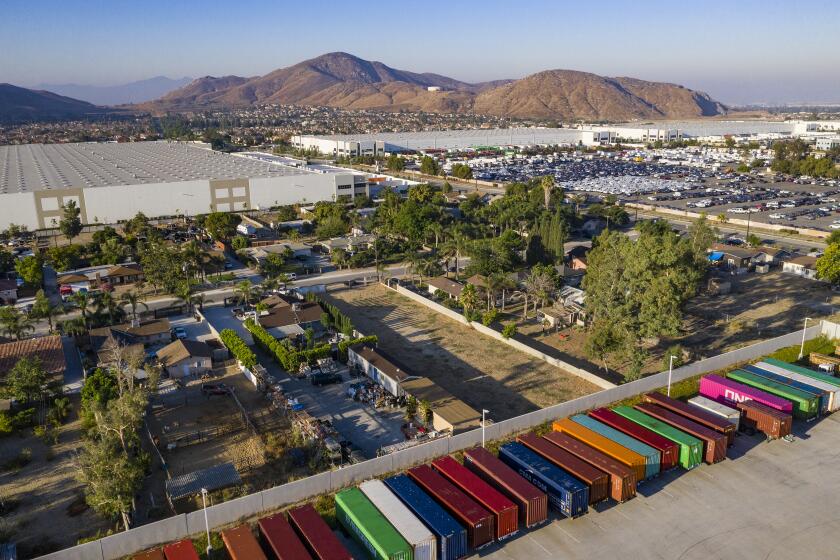Toxic chemicals sullied a Lincoln Heights site. Now, new housing is planned next to it

Nancy Smith remembered that children had called it “the sick land” — the wedge of property alongside the 110 Freeway where a dry cleaning facility had laundered aprons and uniforms for decades across from a Lincoln Heights elementary school.
“We were all up in arms about it because of the children getting sick,” said Smith, who has lived in the northeast Los Angeles neighborhood for more than half a century.
Decades after the old Welch’s laundry was shuttered, California regulators worked to clean up the soil and check the groundwater for the chemicals used there — volatile organic compounds such as tetrachloroethylene that could damage the human liver and nervous system and have been tied to an increased risk of cancer. The Department of Toxic Substances Control oversaw a cleanup effort that lasted for years and has continued to monitor groundwater at the site.
Now, neighbors are worried about what lies beneath the land next to it — a plot where real estate developers are planning a five-story housing project with underground parking. The plan has generated concerns about contamination and gentrification in an area that the state has deemed especially vulnerable to and burdened by pollution.
The development site “has never been tested for pollution, despite lying directly in the path of a well-documented toxic plume that has been flowing for as long as 100 years from the bordering property,” the Lincoln Heights Community Coalition wrote in April. “We are not endeavoring to stop this project, but only to enforce the proper environmental assessment and testing required.”
Fidela Villasano’s entire world was upending.
The project, planned by a real estate development team that includes RMS Corp. and Pinyon Group, could bring 468 housing units along Pasadena Avenue and Avenue 34, including 66 for households with “very low” incomes — around $53,000 or less for a Los Angeles family of three.
Project representatives said that they had seen no evidence that serious contamination had spread underneath the site and that they were proceeding carefully under the guidance of the Department of Toxic Substances Control, which has agreed to their plan to handle any contaminated soil detected during excavation. If gases are found to be rising from the groundwater, barriers will be put in to stop them from permeating the building, they said.
“I’ve worked on a lot of sites that were very contaminated. This is not one of them,” said Andrew Brady, one of the project representatives. “All of the professionals who analyzed it thought there was not a major issue.”
In a November letter, toxic substance regulators said they didn’t believe that residual chemicals at the Welch’s property posed a risk to future residents of the property next door, citing low levels of chemicals in groundwater at the laundry site.
The state agency later said, however, that more testing was needed to determine if the Avenue 34 site was suitable for the planned project. In April, it said it had decided “in an abundance of caution” to collect data on soil and soil gas to check for hazardous substances at the project site, noting that the land had once been used as an electronics assembly site.
Soil gas must be sampled “to support the previous conclusion that there are no impacts from the adjacent Welch’s property,” agency spokesman Russ Edmondson said in an email.
Brady said this month that testing was getting under way and would have happened anyway as a part of the building process. He estimated that results could be processed within a month or two. Critics have raised concerns, however, about the adequacy of the testing plan.
Jane Williams, executive director of California Communities Against Toxics, argued that the Lincoln Heights project was an example of a “constant problem” of regulators failing to check neighboring properties for contamination. Neighborhood activists have pointed out that some of the chemicals that sullied the Welch’s property have been detected in a monitoring well beyond the Avenue 34 site.
“Contamination doesn’t stop at the property line,” Williams said.
In October, the city’s Planning Commission rejected an appeal against the Avenue 34 project after an unusually heated hearing that lasted more than four hours. The Lincoln Heights group sought to challenge the decision but was told this year that it was final and that the appeal had been terminated. It said it is still fighting the plan.
“There’s an elementary school across the street. I have my own children that I’m concerned about,” said nearby resident Patricia Camacho, who filed the initial appeal. “I just can’t believe that it has gotten this far without that site being tested.”
In recent weeks, the group bristled at the news that the Los Angeles City Council was seeking to authorize up to $105 million in bond funding for the project through the California Statewide Communities Development Authority, which is made up of cities, counties and other government entities. Los Angeles is among its members.
Local governments must authorize this joint-powers authority to issue tax-exempt bonds for chosen projects; the bonds are then purchased by private investors. Such funding is meant for “public benefit” projects such as affordable housing.
Councilman Gil Cedillo, who represents the area, put forward the motion to authorize the bonds, replacing a smaller sum that was already approved. A vote is expected this week. His spokesman, Conrado TerrazasCross, said he made the proposal “because the city is experiencing a severe housing crisis.”
In addition to the “very low” income units, 192 units were designated as “workforce” housing — a level pegged at a maximum of roughly $160,000 for a family of three. The site is near a Gold Line stop.
Angelenos invested in a rail system so that “we can build density along rail lines to accommodate the increasing need for housing,” Javier Angulo, a Lincoln Heights resident supporting the project, said at the fall hearing. “This is a perfect site. If not here, where? Opposition to this project is a textbook definition of NIMBYism.”
Critics have contended, however, that the Avenue 34 project is still not sufficiently affordable and that new, market-rate units would instead drive gentrification in the majority Latino neighborhood. At the October hearing, Lincoln Heights resident Amanda Ross-Ho called the plan “nothing more than a violent act of gentrification, racism and oppression.”
The plans hit a nerve because a new generation of residents — many of them the children of immigrants — “have seen their parents hiding in the shadows and they’re not going to do that,” said Dydia DeLyser, a longtime resident of the neighborhood. “They have been watching what’s going on their whole lives and they’re not going to take it anymore.”
The Lincoln Heights Community Coalition and advocacy groups including California Communities Against Toxics and California Safe Schools oppose the financing plan, arguing that it is a misuse of the bond money. Williams questioned why the city would help the Lincoln Heights project secure funds when questions remain unanswered about potential hazards.
Southern California may finally be confronting the public health and environmental damage created by the unchecked growth of goods movement and e-commerce.
TerrazasCross said the development authority had “leftover and unused” capacity for bonds that would have been lost if it hadn’t been allocated to a project by June.
Cedillo “shares community concerns about possible soil contamination at the site, given its proximity to the former uniform cleaning facility,” the spokesman added. “Strict compliance with federal and state regulations is required, but more importantly, public transparency is paramount.”
The councilman said last year that he supported the Lincoln Heights project as long as it met key conditions. Among those conditions: It had to obtain a letter from state toxic substance regulators stating that it met their requirements for its planned use — or had a sufficient testing plan for it.
As of early May, city planning officials had not signed off on that condition being met. Project representative Jerry Neuman said the project had satisfied that requirement because the state agency had signed off on its soil management plan for the site, which lays out how the developers will safely handle any contaminated dirt found during excavation.
Michael Henry Hayden, president of the Lincoln Heights Community Coalition, sharply disputed that argument, pointing out that state regulators said they still needed to investigate more to determine if the site is even suitable for the project. Edmondson, the Department of Toxic Substances Control spokesman, said the project proponents had met the terms of their current agreement with the agency but that agreement would be revised to include oversight of the needed testing.
Smith said she remembered children and teachers suffering nausea and breathing problems when Welch’s was still operating. “How can you tell us that the land is safe,” she asked of the project site, “without you testing the soil?”
More to Read
Sign up for Essential California
The most important California stories and recommendations in your inbox every morning.
You may occasionally receive promotional content from the Los Angeles Times.












